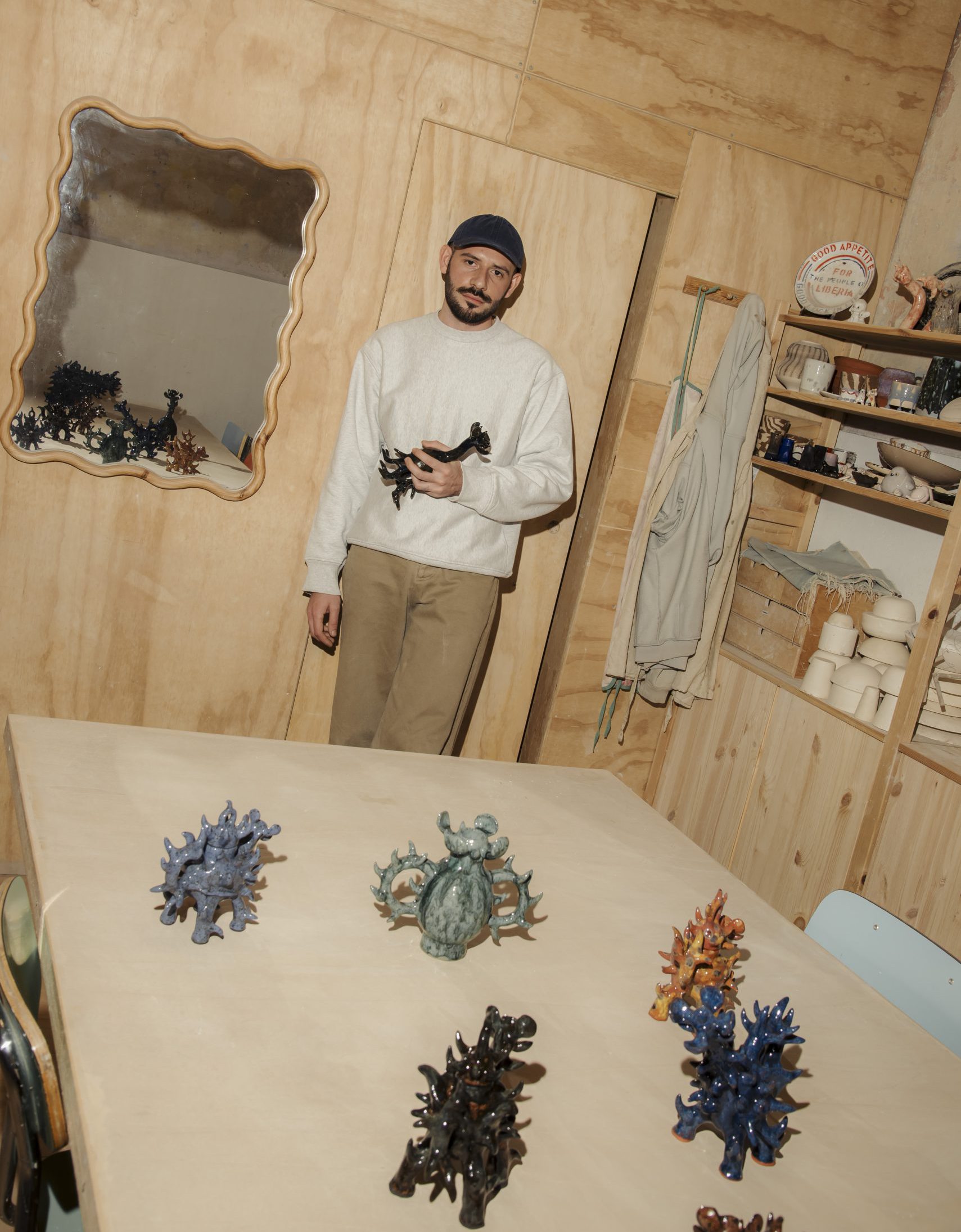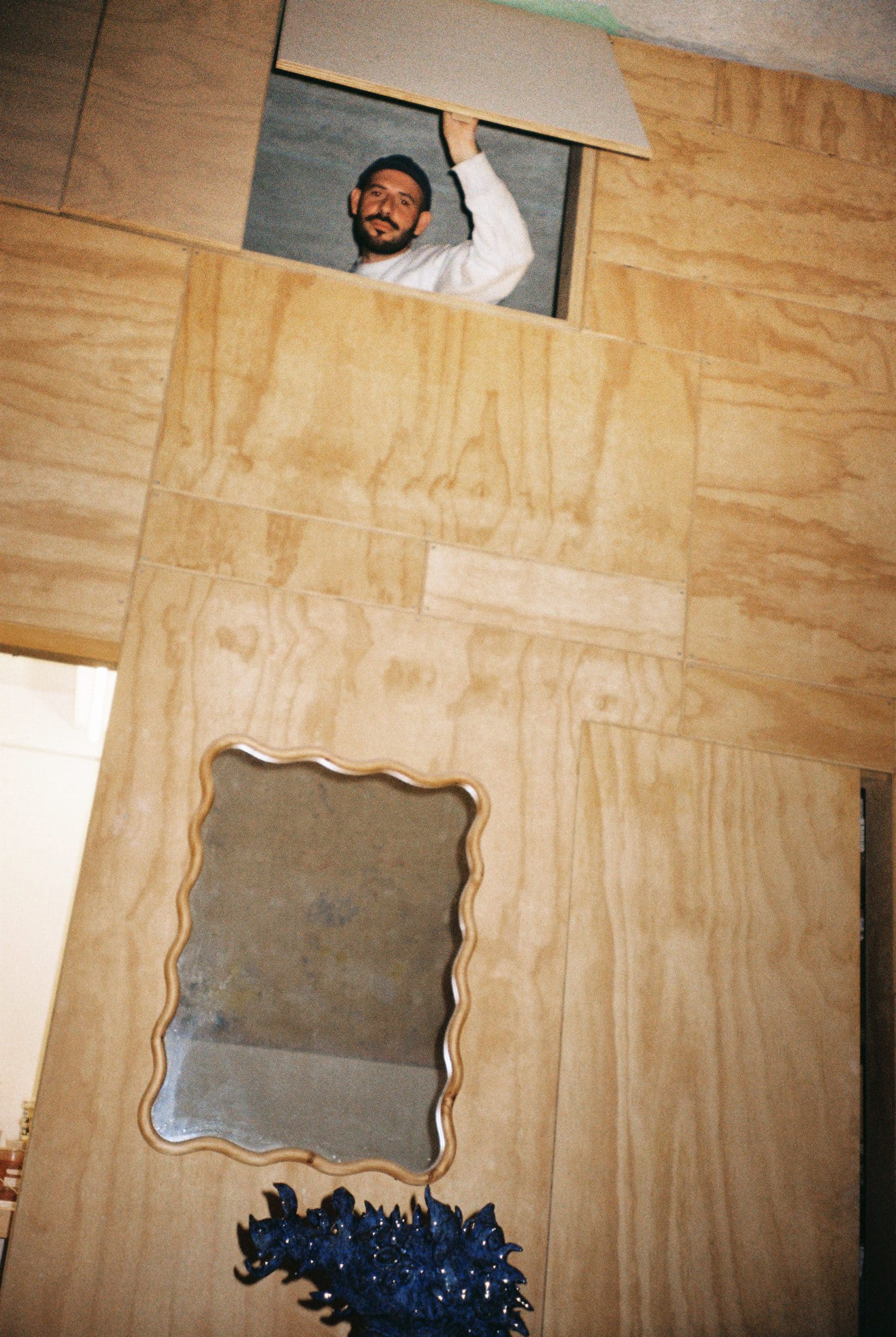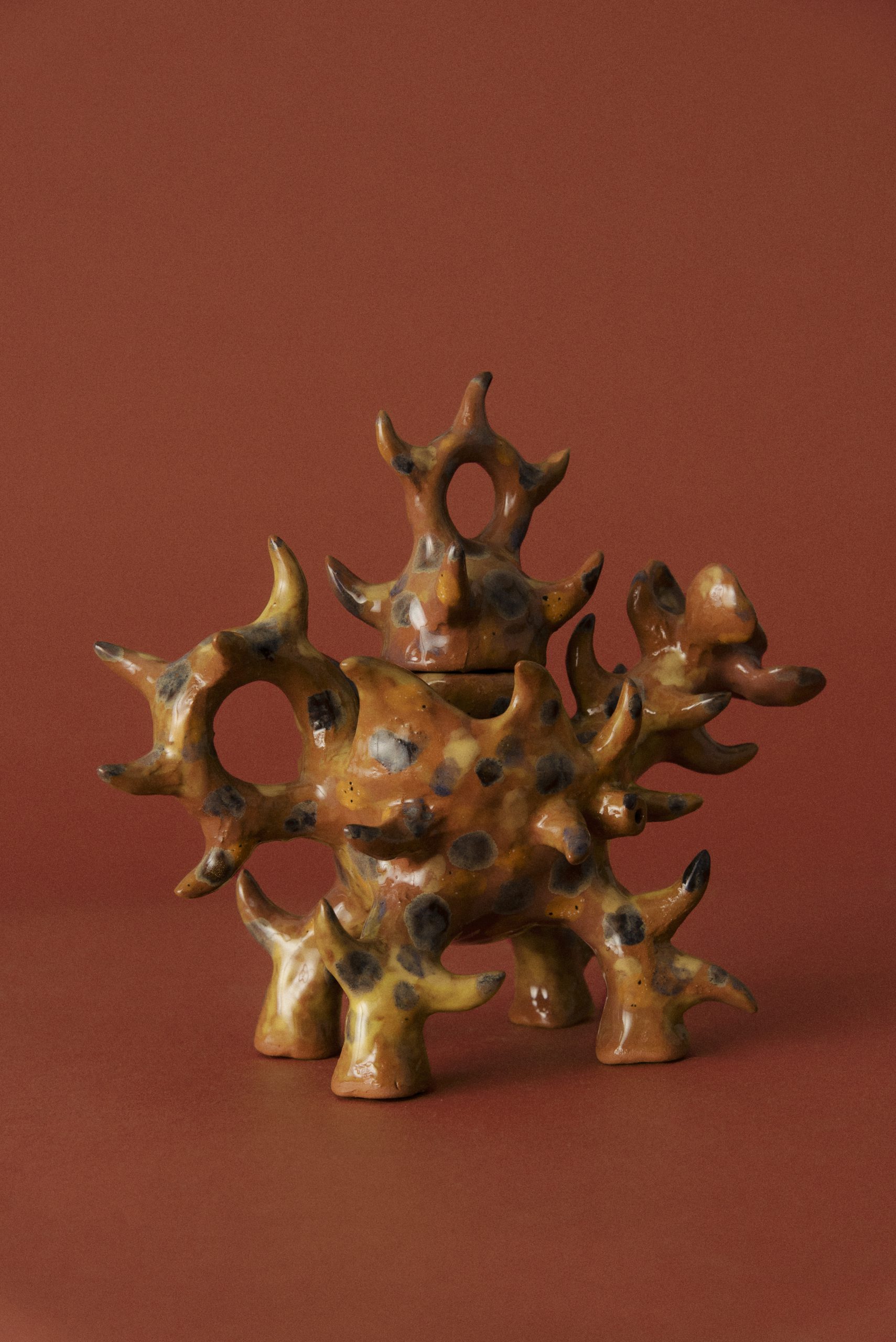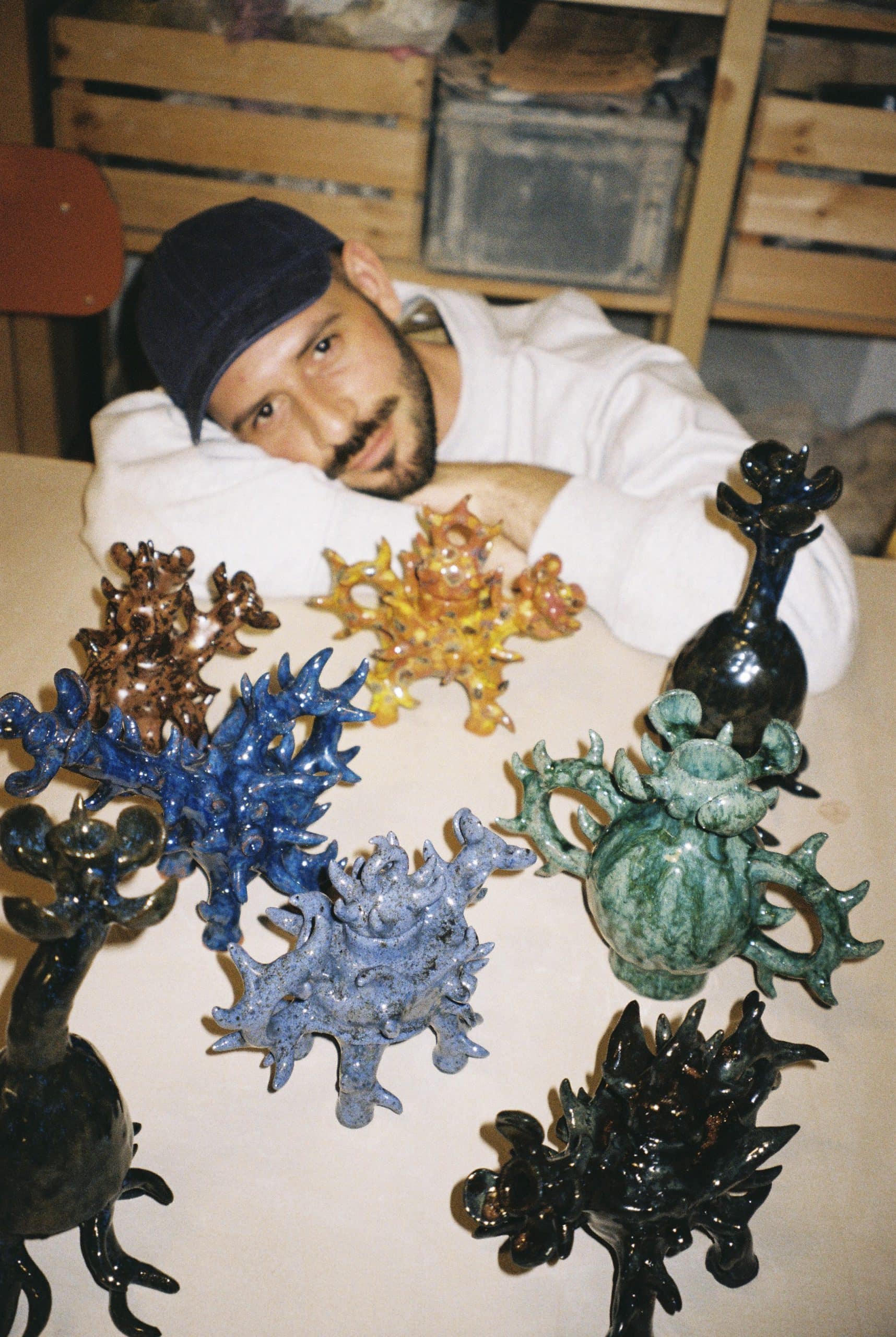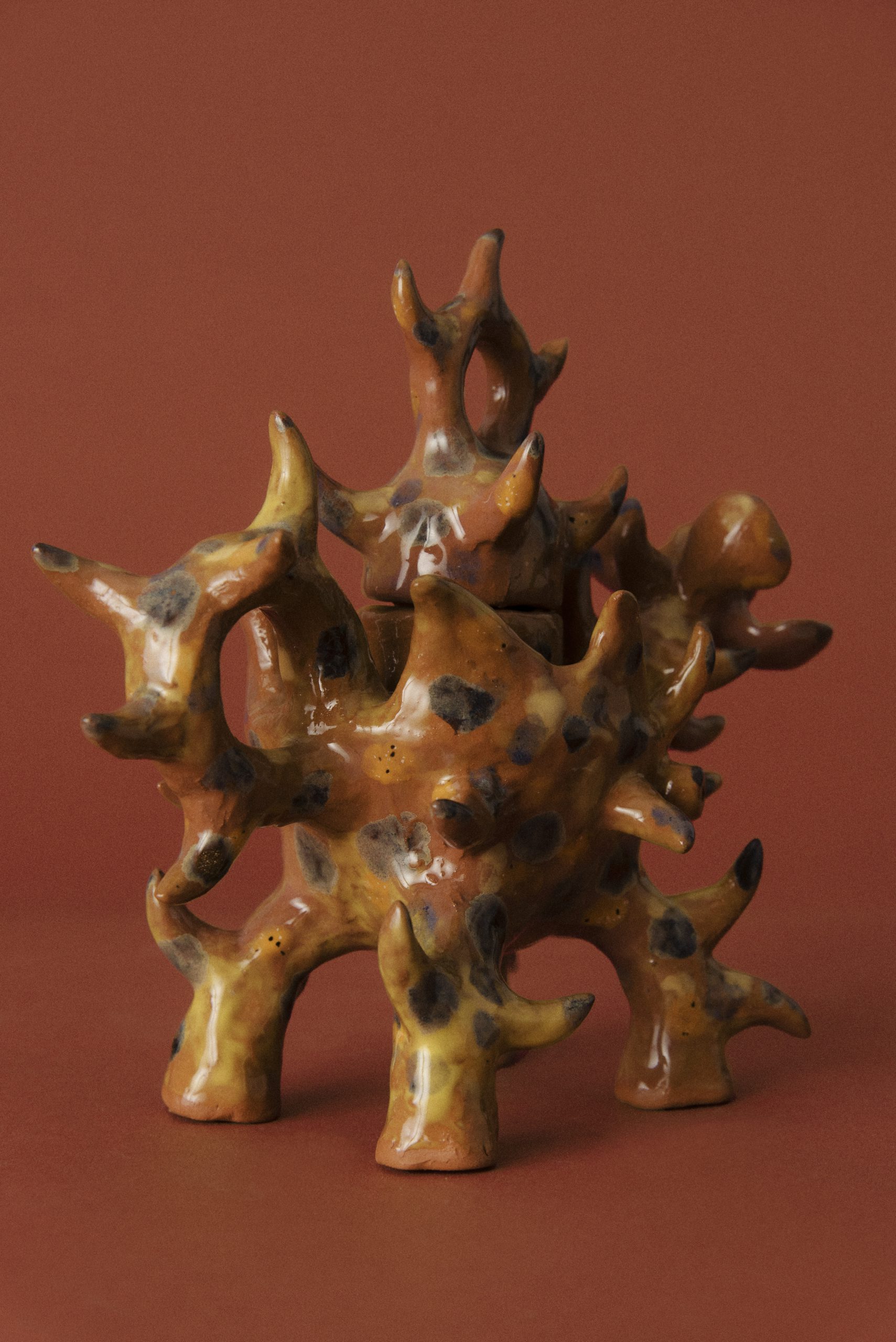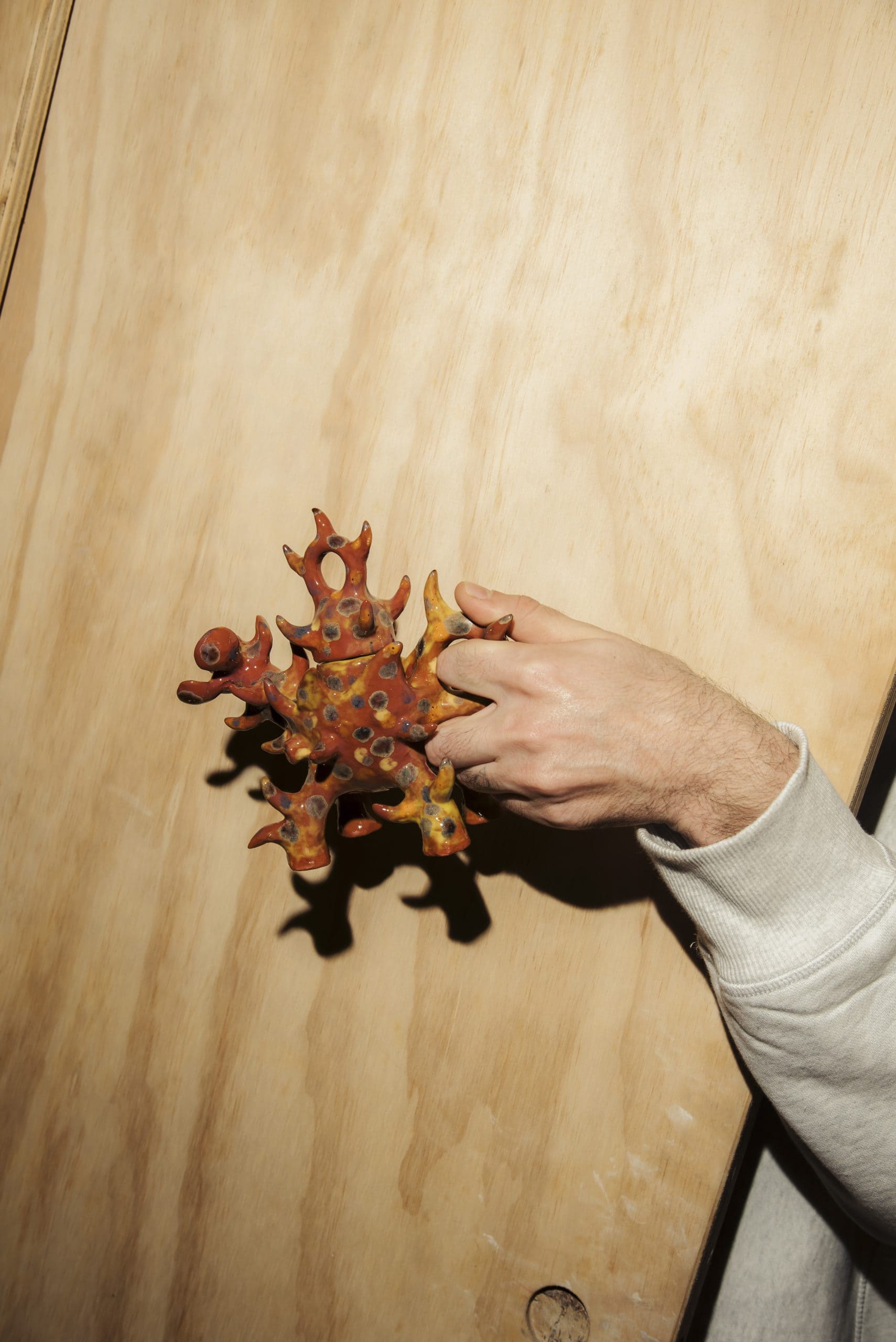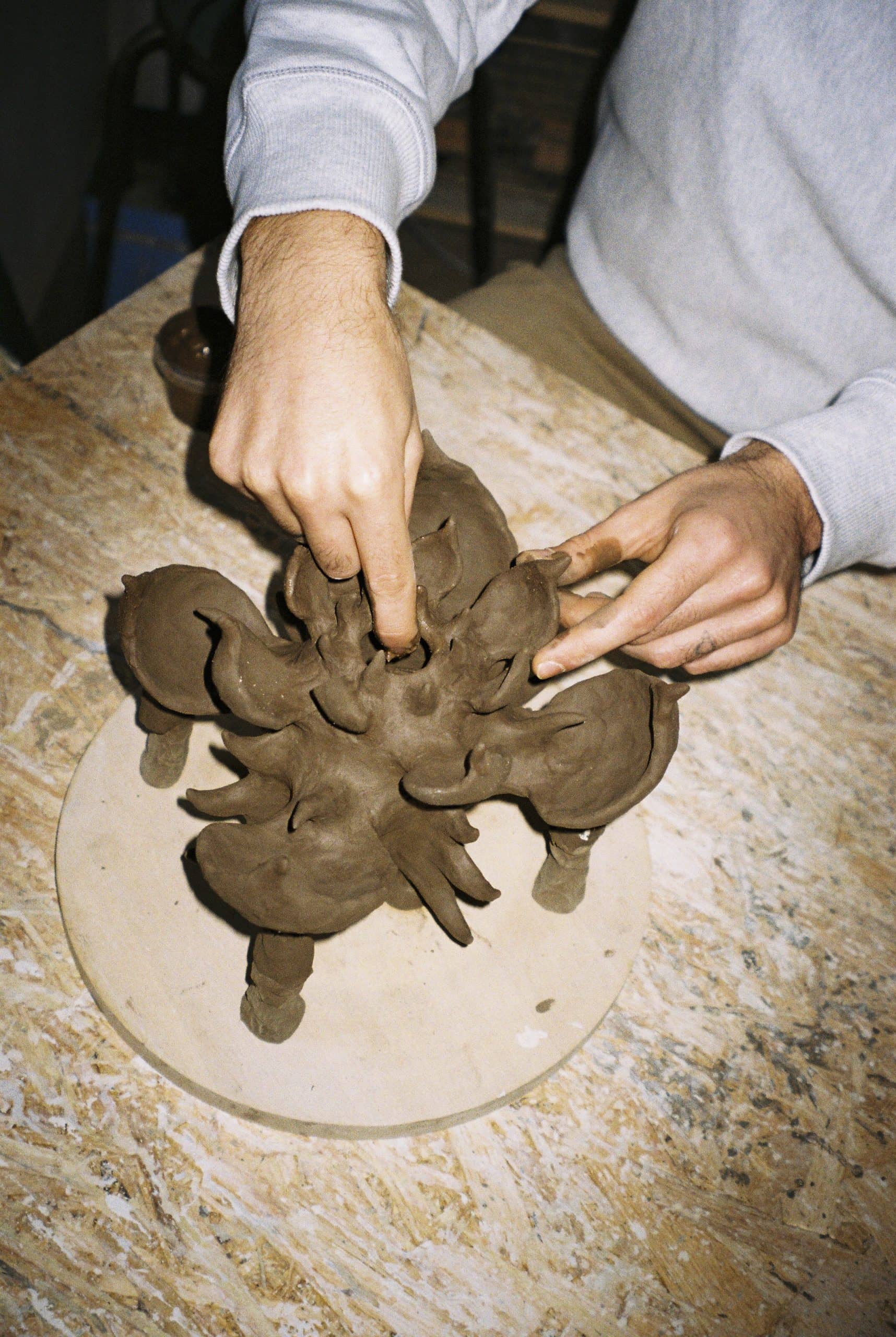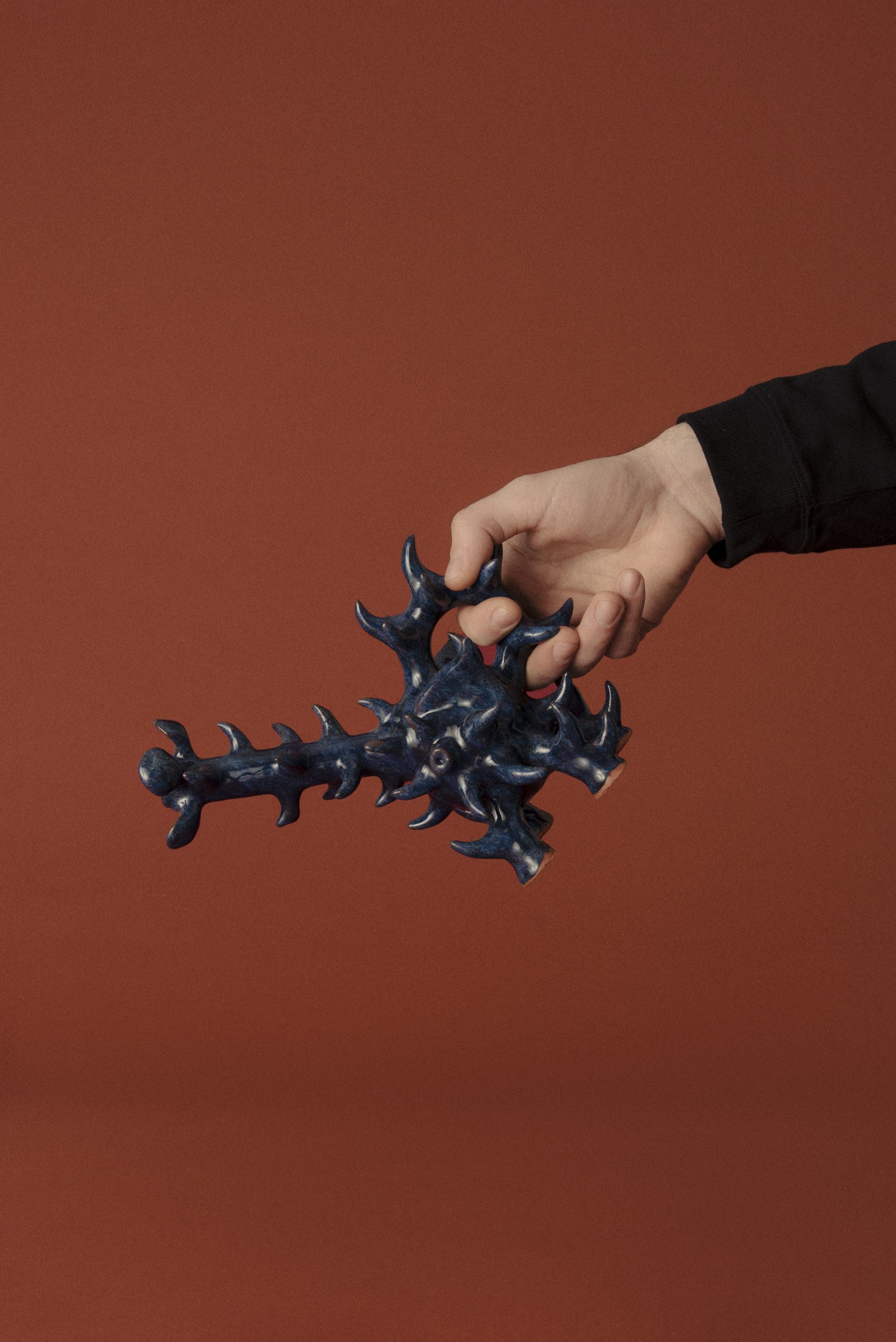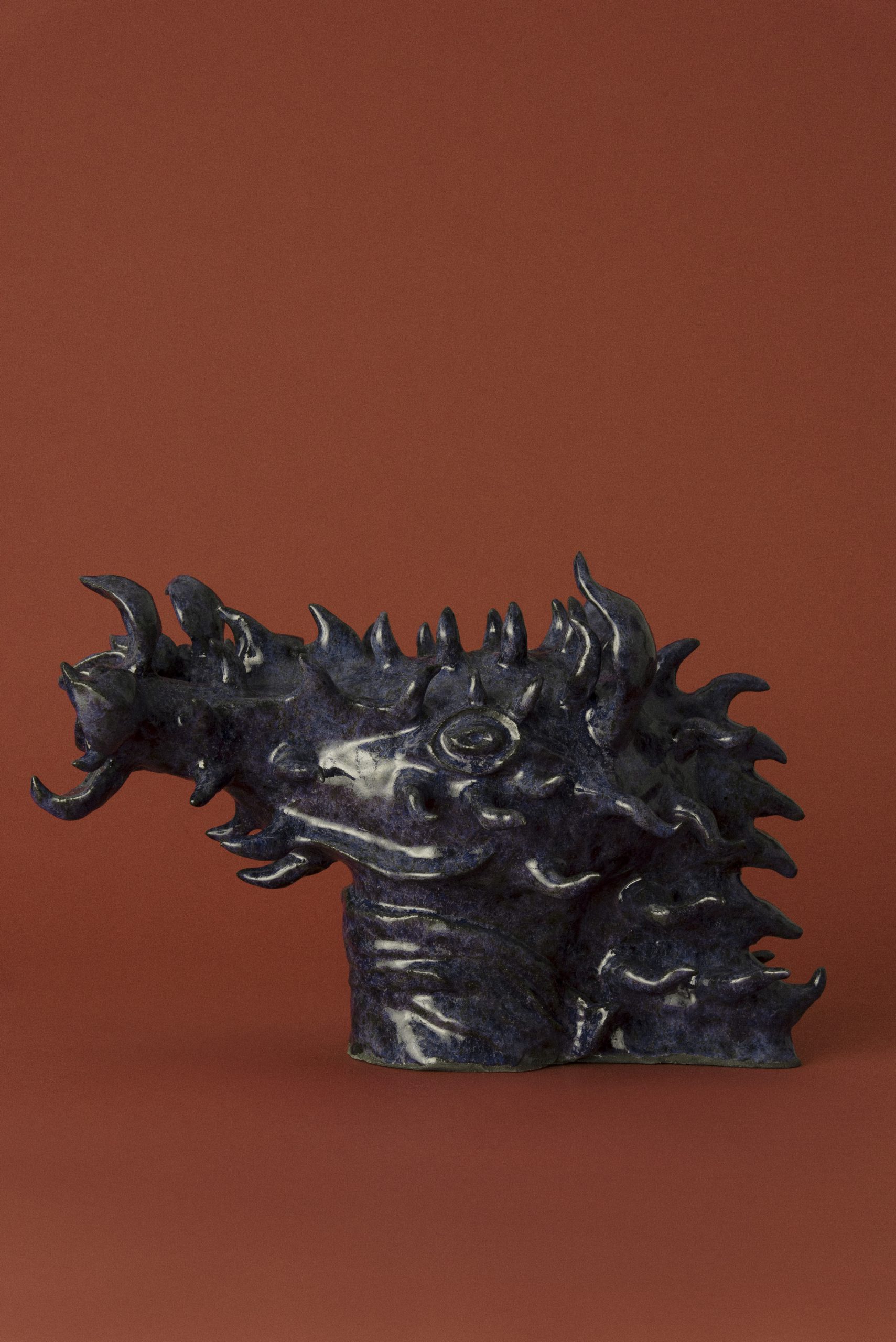Milan has always been a city of contrasts, where fast-paced productivity meets slower, more thoughtful moments. On one hand, there’s the constant drive of people creating without stopping, and on the other, a quieter flow shaped by intuition and unexpected connections. It was in this balance of action and reflection that I discovered the work of Giacomo Lambrugo.
At thirty, and hailing from a small town just outside Milan, Giacomo transforms ceramics into a language of gestures, memories, and rituals. His pieces—some functional, others more abstract—carry a subtle sense of companionship, evoking the delicate presence of a flower in a home or the meditative repetition of a daily gesture. Rooted in materiality, each work seems to hover in the space between reality and reverie, inviting the viewer into a silent dialogue where new connections quietly unfold.
Simone Lorusso: Hi Giacomo, first of all—congratulations on your ceramics! When I first saw them, I was really impressed. I have to admit, I’d love to have one in my own home. During the shoot, you mentioned that ceramics only recently became a part of your life. Is that correct?
Giacomo Lambrugo: Yes, ceramics entered my life fairly recently. After leaving the Academy, where I focused on sculpture, the pandemic hit—and with it came a period of pause and introspection. During those months, almost by chance, I met a woman in the park near my home while she was walking her dog. She owned a pottery studio, though she was quite reserved and never opened it to others. Somehow, I managed to convince her to hold a class, and I began working there with a small group. I was immediately drawn in—ceramics captivated me from the start. But I quickly realized that the environment didn’t give me the freedom I needed. There was a certain possessiveness around the space, and over time, that sense of restriction began to weigh on me. After about ten classes—roughly two months—I decided to step away.
At that point, I began experimenting at home, even though I had no way to fire the pieces. I shaped the clay purely for the sake of the gesture—the works remained unfinished, fragile. Most of them broke. And yet, during that time of forced isolation, the process meant something to me. It became a way to get through the days, to keep a dialogue going with the material. I had moved back in with my parents, far from Milan—I’d left Turro just a few months before the pandemic—and that solitary, almost ephemeral experience deeply shaped my relationship with ceramics. Then, about two years ago, I came across this studio in Milan, and that marked the beginning of a new chapter.
SL: How did you first discover the studio where you now work on your ceramics?
GL: place where anyone can suggest a workshop or activity—just ask, and you’re welcome to use the space. I’d seen a few Instagram stories about it and was immediately curious, but, as often happens with me, I kept putting it off. Then I realized the studio was literally around the corner from my house—and at that point, I thought: it doesn’t get more convenient than this. So I finally decided to give it a try.
The studio is called Claytumno. Ada, the owner, told me she came up with the name through an anonymous poll on Instagram. “Claytumno” ended up winning, but no one ever stepped forward to claim it—so to this day, the name’s origin remains a bit of a mystery.
SL: Where does your interest in flowers come from? Beyond what feels like a natural extension of your painterly touch—as I sensed—how did this fascination develop over time and eventually take shape in a more physical, tangible way?
GL: I think flowers have always been part of my world—not as a conscious choice, but more as a quiet, constant presence. They’ve naturally woven themselves into my interest in animals and in objects that carry a sense of companionship. A flower—whether it’s in a home, a garden, or a courtyard—isn’t just something decorative. It’s a silent presence that transforms a space, changes how we perceive it, and brings a more intimate, dynamic energy.
That’s where I see the link with my work: the desire to create objects that aren’t static, but that invite a kind of dialogue—objects that suggest a relationship. The forms I explore—flowers, animals, or hybrids—come from the same impulse: to give shape to something that lives in the space between the real and the imagined. Something that resists categorization, but finds its meaning in its ability to quietly inhabit a place and connect with the people in it.
SL: Do fairy tales influence your work? I mean the fairy tale in its truest sense—with all its symbols, layered meanings, and storytelling power.
GL: There’s no fairy tale in the traditional sense, no linear story behind my work. But there is definitely a play of imagination—spontaneous connections that bring the objects to life. As a kid, I used to sculpt animals out of cheap modeling clay like Das, and I always felt the urge to give them a place—to make them part of a world. They weren’t functional, but to give them meaning, I’d invent absurd titles, almost like they were characters in a little scene. I remember making a dog with a leash out of tulle and giving it this bizarre caption: “Hunting dog stolen, 75-year-old woman in trouble.” It was my way of giving them identity—of making them feel alive, like companions.
I think that impulse is still with me. My relationship with form and material is never just about how something looks or works. There’s always an attempt to create a connection, to hint at a story—sometimes through a strange detail or an unexpected combination. So rather than fairy tales, what runs through my work is a playful spirit—a desire to let objects exist on their own terms, almost as if they came from a world just slightly different from ours.
SL: In the name and the forms you’ve described, I sense an almost childlike quality—in the most positive and purest sense of the word.
GL: Yes, I do think there’s a strong connection to childhood—but not in a naive or overly romanticized way. It’s something more instinctive and genuine, rooted in my relationship with nature and animals. Since I was little, I’ve felt deeply connected to those elements. I started horseback riding when I was six, and from that moment on, it became a constant in my life, especially during summers. My parents would drop me off at a riding school surrounded by nature and leave me there until evening. That place wasn’t just where I learned to ride—it felt like a second home, a space where being around animals and the outdoors was completely natural.
That experience left a deep mark on how I see the world, and it still shapes my creative process. Even now, flowers, organic forms, and the balance between structure and spontaneity run through my work like a thread—something that ties back to those early, formative experiences.
SL: So, what made you choose the teapot for your work?
GL: The teapot, more than many other objects, carries a layered significance. It’s not just functional or decorative—it embodies an entire ritual. Take the vase, for instance: it’s easy to see it as a companion object. It decorates, defines a space, and expresses a style. But the teapot has a more active, relational quality. It’s tied to moments of sharing, to cultural rituals, to slowing down.
In an age where everything moves quickly and even the design of objects often leans toward reducing or eliminating gestures, the teapot feels almost like an artifact from another time. It resists haste. It requires presence. It’s not just a vessel—it moves with the person using it, becoming part of their rhythm, their daily life, their habits.
There’s a whole choreography of care involved: filling it, pouring from it, washing it. Each step becomes a dialogue with the object, deepening over time. I’ve come to think teapots “speak” in their own way—in the way they sound when they’re full, when the tea pours, when the lid is lifted. They come to life through use, shaped by the gestures they invite. That’s what draws me in—the intimacy they create, the way they foster a slower, more intentional connection between person and object.
SL: That’s a really fascinating way to look at it. Are you currently exploring any new objects or rituals?
GL: Right now, I’m continuing to explore objects and rituals that feel intuitively connected. One gesture that’s always intrigued me is watering—because it carries a kind of dual symbolism. On one hand, you’re nurturing a plant; on the other, you’re pouring tea into a cup. The watering can and the teapot, in a sense, share the same function: to nourish, whether it’s the body or something living around us. I don’t really see a big distinction between the two—they both require care, presence, and unfold through a repeated, almost meditative ritual.
At the same time, there’s another thread I feel is still open—masks. I’ve been fascinated by their expressive power for a long time, though I haven’t fully delved into that world yet. I think it’s partly because, over the past couple of years, I’ve been more drawn to theater. The idea of wearing something, building characters, experimenting with identity through performance objects really excites me. It feels like a natural next step, a new chapter I’d like to explore.
It’s a universe I’d love to enter more fully, but I also know it calls for more structure, collaboration, and skills I don’t completely have on my own yet. I could jump in, find people to work with—but that’s also where my tendency to procrastinate creeps in. It’s not just about my own pace anymore, and that can be intimidating. Still, the desire is there. I just need to find the right moment to act on it.
SL: How do you see the future evolution of your ceramics, both in terms of form and expression?
GL: My goal is to expand the size of my ceramics. I feel the need to push further and experiment on a larger scale. I know this process will take time, space, and the right tools. Right now, the studio I work in is equipped for a certain size, and since I share it with others and with classes, my freedom to move around is limited. On top of that, my full-time job, which takes up 32 hours a week, impacts the time I have available, making it harder to balance creative goals with practical constraints.
Then, there’s the nature of ceramics itself, which follows precise, non-negotiable rhythms: a piece can’t be left to sit for weeks. The process requires constant attention, from monitoring the drying stages to paying attention to the texture of the material and the fragility at every step.
SL: With this in mind, do you think Milan is the right place for your artistic growth—not just in terms of refining your work, but also for your personal and creative development?
GL: I believe Milan, from a work perspective, offers the right balance for me—a mix of creative stimulation, professional opportunities, and a familiarity that I feel is essential at this moment. If I’m being honest, outside of this conversation, I’m not someone who finds it easy to “sell” myself. Moving to a new city and starting over in a completely new context feels complicated for me, at least for now. I can’t yet picture myself anywhere else or naturally envision myself settling into an entirely new environment.
So yes, I think the real challenge for next year will be learning how to navigate my current reality more effectively. Milan has a lot to offer, and while I might not want to live there long-term, I do need to fine-tune my ability to make the most of the opportunities that are already around me. Taking my independence a step further and finding ways to showcase my work more consciously—that’s the goal for 2025.
SL: Have you ever thought about moving back closer to your family, outside Milan, and maybe turning your place into a cultural hub, workshop, or studio? With your connection to nature, it could be a more peaceful space for reflection, away from the hustle and bustle of the city.
GL: Moving back to the countryside, away from Milan’s fast pace, could give me more independence—both logistically and creatively. I’d already have the perfect space to set up my studio: my parents’ house is big, and the basement could be turned into the ideal work environment. I could experiment freely, without the constraints of a shared studio or the limitations of city spaces. Having a dedicated space for my work would let me manage my time more effectively, creating in a quieter, more focused setting.
That said, I do wonder how being away from the city might impact opportunities and connections. Milan has this constant cultural buzz, a network of exchanges that really fuels my creativity. I think the real challenge would be finding a balance between the peace of the countryside and the energy of the city, using the calm to deepen my creative process without losing touch with the dynamic art scene.
SL: I’m curious about how time fits into your creative process. On one hand, you’ve mentioned a tendency to procrastinate, but on the other, your work clearly requires careful time management. How do you manage to bring these two sides together?
GL: I’ve realized that being surrounded by tall, accomplished people and seeing other artists around me really impacts my relationship with time. There’s this constant pressure to make the most of every moment, like I need to hurry because someone might get ahead of me—even though I know it’s not supposed to be a race. Living in the city only amplifies that feeling. Even when I try to block it out, the fast pace of it all still gets to me. I feel like I should be moving faster, but at the same time, I know I have a tendency to procrastinate. This creates a real contradiction for me—this tension between the urgency of time and my natural inclination to stretch it out.
SL: It’s interesting how city life pushes us to move at a frantic pace, almost as if there’s a constant race to keep up. Yet, this directly contrasts with the slower pace of ceramics, which can’t be rushed. Perhaps, in the end, it’s this very slowness that’s actually a blessing?
GL: Definitely, ceramics has this unique quality. When I was painting, I was very impulsive, not respecting the time the medium demanded. With ceramics, though, I’m forced to wait, and maybe that waiting brings a certain order to my mind. Each step is carefully paced: the piece starts raw, moves through glazing, then sits on the shelf. Even visually, the process is broken down into clear, almost ritualistic phases.
This structure gives me a sense of stability. It allows me to reflect, observe time, and truly engage with what I’m creating. Sometimes it’s great, and other times it can feel limiting, but overall, it helps me approach the process with more calm.
SL: In your experience, how many people truly understand that the time spent on ceramics is not just a physical and mental commitment, but also carries an intrinsic economic value? We often talk about fast fashion, but rarely about speed in other art forms like ceramics. Today, many brands use mass production methods, offering items like vases at very low prices. How do you view this dynamic in relation to the value of craftsmanship?
GL: Today, more than ever, the true value of what we buy is often overlooked. People tend to forget the time, skill, and dedication needed to create an artisanal product, while industrial production has reinforced a rapid consumption model where even items with an artisanal look are mass-produced. That said, I do believe there’s a growing group of people who, in a time of crisis, uncertainty, and widespread counterfeiting, are beginning to recognize the real value in what we create, seeing it as something meaningful beyond just ownership.
SL: It made me smile when you hesitated, almost surprised, when asked if you could replicate a vase after it sold, highlighting the element of randomness in your creative process. How much does the unexpected play a role in your work?
GL: There are still aspects of my work that I don’t fully understand. The creative process is full of variables, and I can’t always predict how things will turn out. For instance, the kiln has shelves with varying temperatures, so some areas heat up more than others, adding an element of unpredictability. I’m also not one to obsess over details like cleaning the brush between passes, which sometimes leads me to mix glazes more randomly. When the piece is finished, it’s done, and there’s no way to replicate it. Occasionally, I regret not having thought it through more carefully—like with that orange teapot with the dots I showed you earlier. I find it really special.
SL: Thank you, Giacomo, for sharing your journey and vision with me. It’s been fascinating to learn how ceramics became your expressive language and how each of your pieces tells a story through gestures, rituals, and connections. Your view of objects as living presences, engaging in dialogue with those who use them, is both captivating and profound.
I wish you continued experimentation and growth as you pursue your research with the same passion and authenticity. I look forward to seeing where this creative journey takes you. Thanks again for your time.
